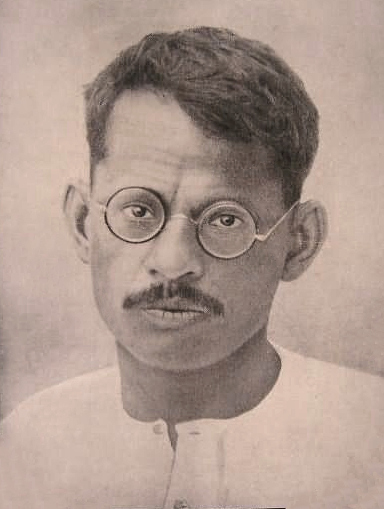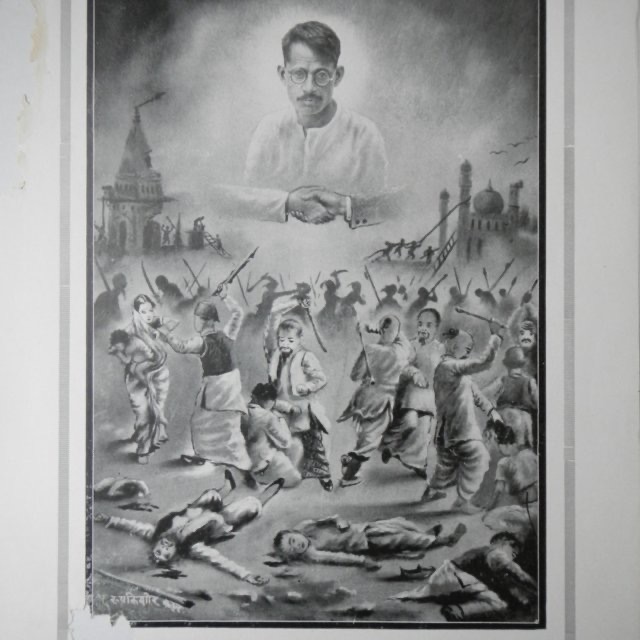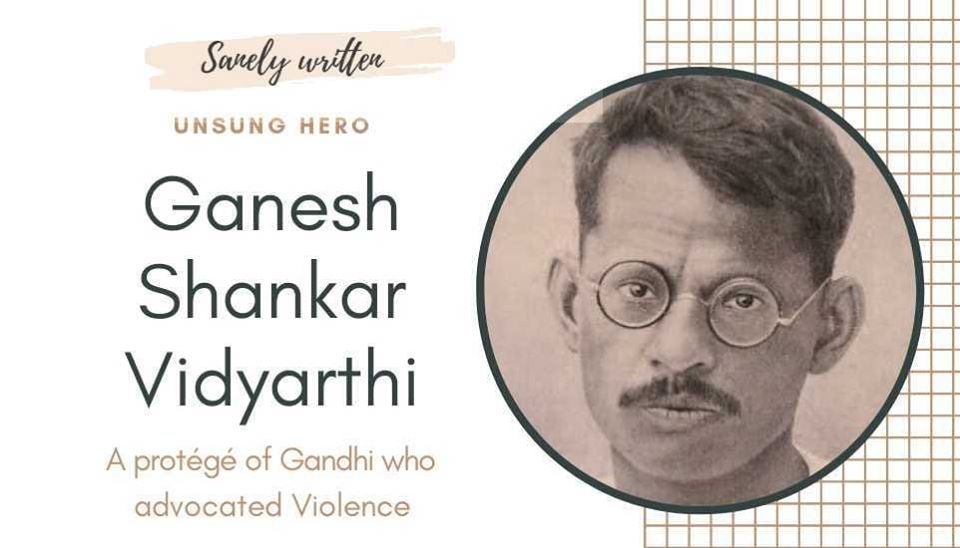What would be the most sublime death? Perhaps it is a subjective question and each person would add his own idiosyncratic way of dying. For a soldier it would be on the battlefield, facing the foes. For many, the best way of departure would be sleeping and not waking up again. And still, those who would die saying that they don’t want to die. But, the name on the top of this blog died a strange death. One where the process of dying would melt even the most dispassionate hearts. But the glory in that dying was even envied by the Mahatma.

Ganesh Shankar Vidyarthi was the darnedest figure in India’s freedom struggle. A protégé of Gandhi but a doubter in non-violence, the man was a rebel in his own ways. Born on October 26, 1890 in the conditions similar to the most Indian families of the time. He was born in a poor family and home schooled by his father who was a middle school teacher. Poverty forced him to be a clerk and then a teacher in Kanpur, but it was journalism where his heart resided.
When the conditions were less harsh, he completed his M.A. from Allahabad University. Works of John Stuart Mill, Shakespeare, Rabindranath Tagore, Tolstoy, Surdas, Kabir, Sinclair and Victor Hugo shaped his social and cultural ideology whereas the columns of Abhyudaya of Madan Mohan Malaviya crafted his political views. Mahabir Prasad Dwivedi identified his rare talent and asked him to be the sub-editor of his monthly ‘The Saraswati’ but Vidyarthi (meaning seeker of Vidya, a surname that he took around 1910) was interested in joining Abhyudaya, the paper that taught him worldliness.
In 1913, he started his own paper Pratap which was a weekly magazine at first but soon became a full-fledged daily. The editorials in Pratap were pure gold. He covered everything from integration of India, negligence of arts, education and agriculture by the British to preaching columns where the Vidyarthi made his readers, students of communal harmony. In 1915, he wrote pieces ‘Nationalism’ and ‘Hope for the nation’. These two pieces are some of the finest works that draws a clean line between nationalism and communal identities. He reprimanded the Muslims not to consider Turkey or Mecca as their birthplace because when they die, their grave would be dug in India. It was in the same year when he was fined ₹1000 for his article ‘Saudawatan’. In 1916, he met Gandhiji in Lucknow. This meeting gave a new dimension to the life of Vidyarthi. The days of desk-work and dispatching papers from the comfort of the homes met an end. The pages in his paper started growing. But this time, Vidyarthi was out on the roads treading on the path showed by Gandhiji. He worked hard tirelessly on field to weaken the seeds of communal bitterness sowed by the British. He advised both Hindus and Muslims not to beat drums in front of mosque and temples on Dussehra and Muharram. He led the Kisan Andolan in Rai Bareilly in 1921. British suppressed the Andolan inhumanely in which many farmers lost their lives. Motilal Nehru and his son Jawaharlal were the eye witness of this case along with fifty others but no one dared to speak against the British Rule and the Sessions Court judge blamed Vidyarthi and his paper Pratap.
If a spectrum of ideological methods devised in the freedom struggle is created and Gandhiji and Shahid Bhagat Singh sits on its opposite ends, it will make complete sense if we see Vidyarthi everywhere in between. Vidyarthi took Gandhiji as a father figure but didn’t hesitate to differ from his preachings of non-violence. He argued that there should be no discussion about violence or non violence because the British government is reigning with animalism. He gave shelter and monetary help to Bhagat Singh, Ram Prasad Bismil, Ashfaqullah Khan, Chandrashekar Azad and Batukeshwar Dutt. Vidyarthi performed the Kanyadan for the daughter of Roshan Singh after he was tried for Kakori Conspiracy case. He went to meet Asfaqullah Khan on his request, a day before he was hanged. He met and saluted him with eight other friends. He constructed a mazar where Ashfaqullah Khan was buried.
Ganesh Shankar Vidyarthi never wrote to appease a particular community. His life was dedicated to raise voice against communal frenzy. He was jailed for five times, out of which three times he made a trip to jail for his pieces in Pratap and for the rest two times for his speeches against the British. In one of such speeches he said that violence was an intrinsic feature of humans. This statement landed him in jail for a year and he was fined for ₹100. He was one of the first Indians who figured out that the history of India was distorted on purpose by the foreign scholars who created racial stereotypes about Indians. He pointed out how the British scholars portrayed Brahmins as a symbol of cruelty and Chhatrapati Shiva Ji as a thief.
Communal riots broke in Kanpur in march 1931 when Muslim shopkeepers refused to close their shops on the request of Hartal by Hindu congressmen. Vidyarthi threw himself in the riots and at many instances saved Muslims from Hindu crowd and Hindus from Muslim mob. The worst phase of riots began after the hanging of Bhagat Singh on March 23. Vidyarthi was shattered by the loss of his friend. But he had his dharma ahead of him, so he didn’t mourn for long. He asked help from deputy collector and he promised to provide him with escorts. But, as evident from the letters written by Vidyarthi a day before his death, the police did nothing but watched the bloodbath like a spectator. On march 25, Vidyarthi found a young Hindu who had saved about thirty muslim men, women and children from the blood thirsty mob. The injured had to be taken to the hospital in a lorry without any escort. Meanwhile, the crowd had set houses on fire. Vidyarthi helped people come out of their burning houses and sent the injured in rescue lorry. After the lorry loaded with the victims left, he was left alone with few volunteers. The two constables who were accompanying them also left. Now, Vidyarthi was trapped between two crowds from both directions of the road, bareheaded and barefooted. The first set of crowd reached him but he was not touched because some among the crowd recognised him from the previous day helping Muslims. But the other set of crowd wasn’t so thoughtful. He was dragged on the lane by the crowd. The volunteers tried to stop it but Vidyarthi Ji denied any help and said that it was his destiny to die while doing his duty. One volunteer was stabbed to death and others fled for their lives. Now, Vidyarthi was alone amongst the cruel mob. One among the mob bowed his head down and the other stabbed him in the back with an axe. Once he fell, he was stabbed multiple times and stamped upon by the feet of the mob. His dead body was found two days later in a gunny sack. His face was completely disfigured and his identity was confirmed by his clothes, letters in his pockets, peculiar hairstyle and a tattoo on his arms. Mahatma Gandhi said that his blood was the cement that would ultimately bind the two communities.

So, ask yourselves, could this ever be your ideal answer for the most sublime death? We are here, free to imagine answers to such fancy questions only because men like Ganesh Shankar Vidyarthi, who had a fine career in Journalism moved to streets, saved innumerable lives irrespective of religion and even embraced the soul crushing death.
Reference/s :
• The lone ranger, Indian History Congress
• Makers of Modern India
• Ganesh Shankar Vidyarthi, Publication Division by Dr. M.L Bhargava




9 replies on “Ganesh Shankar Vidyarthi & Kanpur Riot of 1931”
Great man
Great insights to the stories of our unheard-of heroes??
The way things are written in this is appreciable because i have never seen such a structured content that you all are delivering . Good job. Keep going, you are on a right track.
-Diwajais
This generation need to know about these men. Beautifully written, Great work.
Thankyou for acknowledging us about such great freedom fighters
A true hero indeed. We can all agree on one thing: He deserved better.
This valiant man was killed by those,whom he once saved.
What lesson should I take?
[…] রয়েছে মুসলমান দাঙ্গাবাজদের বিরুদ্ধে ক্ষোভ উগরে দেওয়ার গল্প, তেমনই রয়েছে দাঙ্গার ছলে ব্রিটিশ […]
I had read just a few lines about this hero in Nehru’s autobiography in the chapter on communalism. Your article is absolutely brilliant. Thank you very much for the information and the photo. Regards